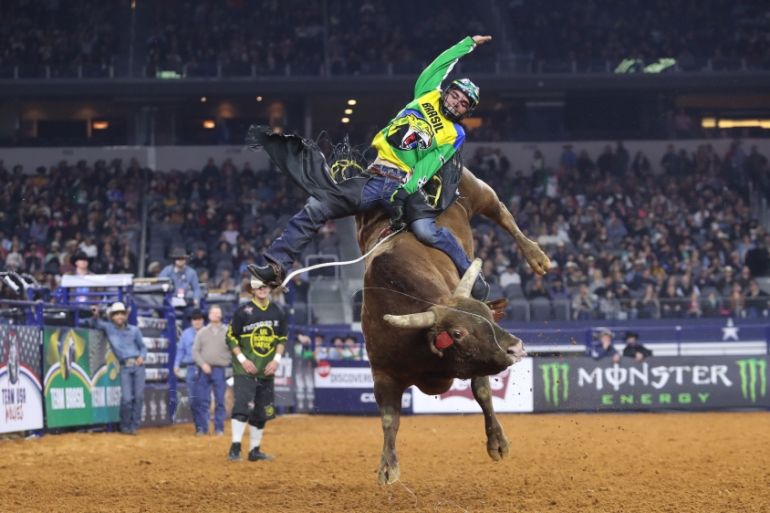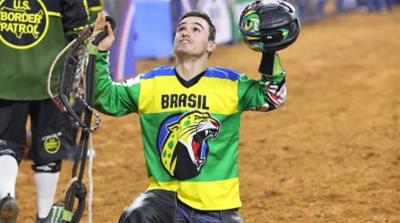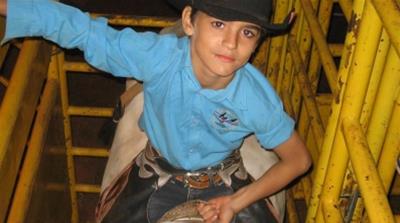‘Million-dollar rodeo: Western culture finds new audience
The global appeal of bull riding makes fans cheer. But does it threaten small-town businesses that gave rise to rodeo?

At five feet six inches tall and 139 pounds, Jose Vitor Leme is fast, strong and gifted with a knack for intense concentration under pressure. As a teenager, the Brazilian native played on several semi-professional football teams, but it was not until he was 18 years old and jumped on a bull that he found his calling.
“Football is a sport that requires a lot of speed, fast movements, and concentration. It helps me in riding bulls,” he told Al Jazeera.
Keep reading
list of 4 itemsKiptum remembered in Kenya’s London marathon double
OJ Simpson dies after battle with cancer
British runner completes challenge to run length of Africa
Bull riding at a rodeo can be dangerous: competitors tighten their legs around a bull’s back and grip the saddle, trying – for eight exhilarating seconds – to avoid being thrown off of an animal that weighs more than a tonne. Injuries such as concussions are common, and can sometimes be fatal. In January, American cowboy Mason Lowe died after a bull stomped on his chest.
Two years after taking up bull riding, Leme boarded a plane for the United States to compete with the world’s best cowboys. He became Professional Bull Riders (PBR) rookie of the year, and took home $416,000. Today he leads the 2019 championship field of cowboys, nearly 330 points ahead of his nearest rival.
Global appeal: More than just white US cowboys
Leme is not the only young Brazilian finding success in a sport that’s traditionally the preserve of white American cowboys. The current third-ranked PBR rider, Joao Ricardo Viera, is also from Brazil. And the defending champion and winner of last year’s $1mn prize, Kaique Pacheco, is from a town outside Sao Paulo. Experts say bull and bronc rodeos are the second most-attended sport in Brazil.

It fits into the culture of instant gratification; it has a unique nature.
“There’s a great cowboy culture in Brazil,” Sean Gleason, the CEO of PBR, told Al Jazeera.
The Brazilian riders’ success is indicative of the growing global appeal of the rodeo. PBR events are held in five countries: Australia, Brazil, Canada, Mexico and the US. Its events are broadcast in 180 territories around the world.
The PBR is also now actively seeking out new audiences by running advertisements centred on women and non-white cowfolk.
Riders can earn up to $118,000 for staying aboard a bull four times over the course of a week-long competition. More than 600 bull riders from five countries now compete for more than $10 million in annual prize money.
The bull’s business

“Culturally, it’s a lot easier [for international audiences] to have an interest in Professional Bull Riding than, for example, American football,” says Jason Belzer, president of Game, Inc. a career management company for sports coaches. He goes on to explain how bull riding “fits into the culture of instant gratification” in that “it has a unique nature”.
The rodeo business has developed a sponsorship platform and return on investment that few other industries can match. A dedicated rodeo television channel claims to attract half a billion viewers, and last year PBR launched a Netflix-style monthly subscription service.
Throughout the year, the world’s leading riders tour North America, Brazil, and Australia, filling stadiums such as New York City’s Madison Square Garden to capacity.
Cowboys of Europe, Australia and beyond
The Australian Professional Rodeo Association oversees more than 100 rodeos a year, while the Mount Isa Mines Rodeo in Queensland was named best festival and event by the Australian Tourism Awards for two of the past three years.
In Europe, France has several rodeo events. The Equiblues festival in Saint-Agreve sees up to 200 cowboys and cowgirls compete across events such as mounted shooting and barrel racing. Just outside of Paris, the annual American Tours Festival has a full-blown rodeo. “The rodeo is one of the most spectacular animations during the event, and every year the benches are full of people,” the American Tours Festival’s communication manager, Julien Dumas, told Al Jazeera.
Rodeo organisers are actively looking to expand to potentially lucrative European and Asian markets, but there are challenges. Gleason says expansion means dealing with stringent cattle movement restrictions. Bucking bulls are uncommon in many parts of the world, and while that only adds to the allure of the sport, it often requires that the animals be shipped from the Americas to new markets.
The downside of growth
While the number of US rodeo events in 2017 increased to 650 from a low of 560 in 2009, it’s still far below the high of 798 events held in 1991, according to figures from the Professional Rodeo Cowboys Association. Decades ago, rodeos were smaller. And today, though there may be fewer events, they are larger and attract more people. Ironically, the growing popularity of stadium-size rodeo events threatens the very small-town American Western culture that bull riding promotes.
Market data suggests rodeo lovers prefer massive events to the small and local rodeos that used to dot the Western US. That – combined with documented rural population loss – means smaller companies that cater to the local market for equine and Western lifestyle products are struggling.
In a world where attention spans are ever shrinking and phone-centered, the rodeo with its short bursts of dramatic action appears well-suited for modern tastes.
Leme, who lives with his wife in the small town of Decatur, Texas, believes the flow of rodeo talent out of Brazil is unlikely to slow. “There are many different championships in Brazil today,” he says. “I think there are more opportunities [for riders] than before.”